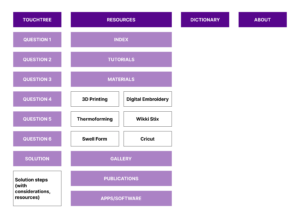Tactile Troops
PROJECT DESCRIPTION

Description: TouchTree is an online decision tree that museum practitioners can use to evaluate how to create a tactile touch object experience for a given museum artifact. Touch objects refer to tactile representations of museum artifacts that visitors may touch directly. The goal of the project is to evaluate the existing prototype based on identified user needs, and make subsequent updates. The existing prototype has been created in Spring 2023 by Syeda Anjum, based on the research led by Lauren Race on touch objects in museums.
Here is a link to the updated prototype.
DESCRIPTION OF PROJECT TEAM NAME
Our team name is Tactile Troops. The name was an outcome of a brainstorming session with all the team members. We mind mapped a lot of words that we associate with the project, and subsequently finalized on Tactile Troops. It is a fun way of depicting our support for bringing tactility to museum experiences!
GROUP INFORMATION
- Group Members: Yi Chen, Aditya Garyali, Ayushi Shah
- Project Mentor(s): Cheryl Fogle-Hatch
- Meeting times: Tuesdays, 4:00pm
OVERVIEW OF SIGNIFICANT ACHIEVEMENTS
- March 3, 2024 : Cheryl and Tactile Troops first meeting
- April 2, 2024 : Tactile Troops completed a site map for Cheryl’s grant proposal
- April 16, 2024 : Tactile troops kick off usability testing
- April 23, 2024 : Tactile Troops start finalize on the ideas, and start updating the prototype
- May 2, 2024 : Prototype is complete
LEARN MORE ABOUT THIS PROJECT
Next steps
- Explore the possibility of letting users save the solution page as a PDF.
- Add case study(s) to the Gallery section that reflect the process that a particular museum followed to create a tactile graphic.
- Continue adding more resources to each category to make it more comprehensive and helpful.
- Since cost is a factor for museums, especially smaller ones when it comes to making tactile graphics, explore ways to add cost information in the prototype.
- Consider explaining the benefits of having tactile experiences and how they help everyone and not just people with disabilities, through the prototype (since one of the problems we identified was that it’s hard to convince museums to create tactile graphics).